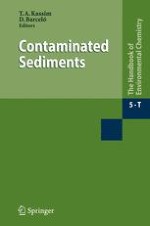2009 | OriginalPaper | Buchkapitel
Marine Sediment Toxicity Identification Evaluations (TIEs): History, Principles, Methods, and Future Research
verfasst von : Kay T. Ho, Robert M. Burgess
Erschienen in: Contaminated Sediments
Verlag: Springer Berlin Heidelberg
Aktivieren Sie unsere intelligente Suche, um passende Fachinhalte oder Patente zu finden.
Wählen Sie Textabschnitte aus um mit Künstlicher Intelligenz passenden Patente zu finden. powered by
Markieren Sie Textabschnitte, um KI-gestützt weitere passende Inhalte zu finden. powered by
A common method for determining whether contaminants in sediments represent an environmental risk is to perform toxicity tests. Toxicity tests indicate whether contaminants in sediments are bioavailable and capable of causing adverse biological effects (e.g., mortality, reduced growth or reproduction) to aquatic organisms. Several environmental management and regulatory programs concerned with contaminated sediments use this approach for assessing risk. However, a limitation of the toxicity testing approach is that the results indicate only if toxicity is present in a given sediment sample. Toxicity test results do not provide information on the cause of toxicity; that is, what specific toxic chemicals are responsible for the effects observed. Information on the cause of the effect is important in performing risk assessments and determining remedial actions at contaminated sediment sites. Methods called Toxicity Identification Evaluation (TIE) procedures were originally developed for industrial and municipal effluents to determine the causes of toxicity in waters affected by these discharges. The TIE approach combines toxicity testing with simple chemical manipulations to selectively alter the toxicity of specific classes of toxicants in a sample. These aqueous TIE methods were later adapted for use with contaminated sediment interstitial waters. Now, whole sediment TIE methods have been developed for both freshwater and marine sediments. This chapter will focus on the development of TIE methods for marine contaminated sediments. Like the aqueous-based TIE methods, the whole sediment TIE methods combine toxicity testing with chemical manipulations to selectively alter the toxicity of potential classes of sediment contaminants. By selectively altering the toxicity of potential classes of toxicants followed by comparison to the toxicity of an unmanipulated sample, it is possible to characterize and identify the causes of sediment toxicity. Currently, interstitial water and whole sediment TIE methods are designed to detect toxicity caused by cationic and anionic metals, nonionic organic compounds, and ammonia, although methods for other toxicants including hydrogen sulfide and specific pesticides are under development. This chapter will provide an overview of the TIE approach and methods for both marine interstitial waters and whole sediments. The chapter will conclude with a brief discussion of new applications for sediment TIEs as well as research needs for the continued development of sediment TIE methods.
